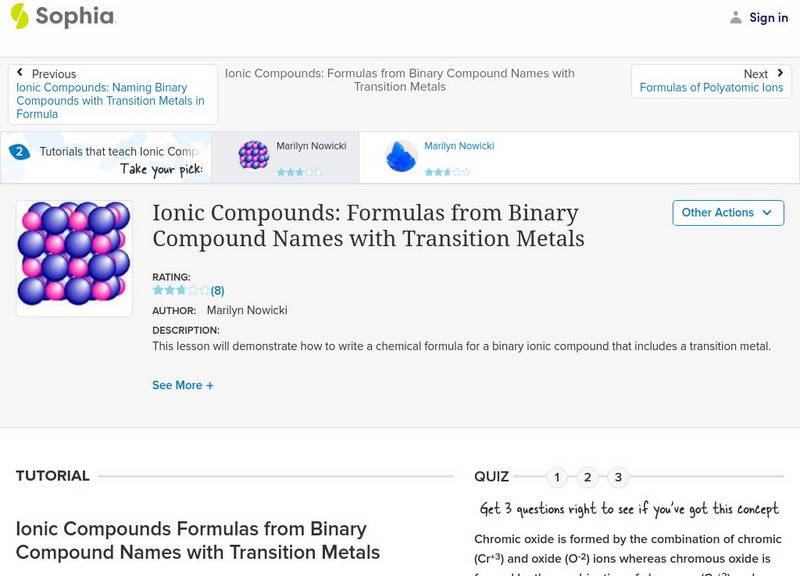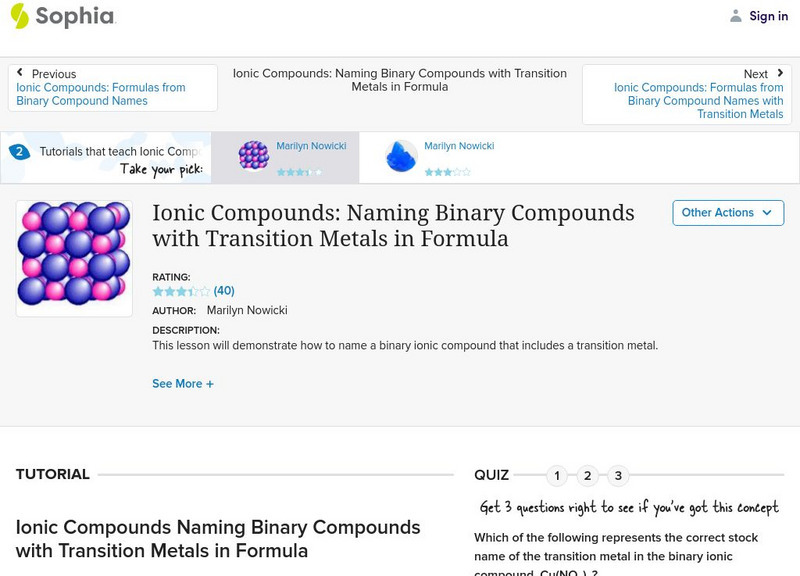SciShow
Mercury Shouldn't Be Liquid. But It Is.
Mercury, a.k.a. quicksilver, is famous for being a liquid at room temperature...and also below room temperature. But you can't use a high school chem class to explain why. Instead, we need a little help from Einstein.
Curated Video
Using ROMAN NUMERALS to name Ionic Compounds w/ a Transition Metal in Chemistry!
Transition metals are elements in the d orbital. The reason these are unique is that they do not have 1 set charge they become when they become an ion like elements in the s and p orbital. Elements in the d orbital, or our transition...
Curated Video
Transition Metals
Transition metals are the largest group in the periodic table. Find out what similarities they share, and how we make use of these metals. Chemistry - Periodic Table - Learning Points. Transition metals are found as a block in the middle...
Curated Video
Iron and Luminol
We use potassium ferricyanide and luminol indicator to show how forensic scientists detect blood at crime scenes. The luminol indicator contains luminol, sodium hydroxide and hydrogen peroxide. When luminol comes into contact with the...
Catalyst University
How to Determine Reactiveness/Lability of a Metal
How to Determine Reactiveness/Lability of a Metal
Schooling Online
Chemistry Properties and Structure of Matter: Properties of Matter - Naming Hydrated Salts
This lesson will explain the differences between hydrated and anhydrous salts, including how to write their names and chemical formulae.
Definitions included: hydrated salt, water of crystallisation, anhydrous, anhydrate, aqueous salt
Catalyst University
Purine Catabolism: Conversion of Hypoxanthine to Uric Acid
Purine Catabolism: Conversion of Hypoxanthine to Uric Acid
Curated Video
Ionic Compound Formation Explained
This video is an educational presentation on how to form compounds through understanding the charges on various ions. The viewer learns about the formation of positive and negative ions in metals and non-metals, how to predict the charge...
Catalyst University
Corrin/B12 Biochemistry: Cobalamin Reductase
Corrin/B12 Biochemistry: Cobalamin Reductase
Catalyst University
Pi-backbonding with Strong-Field Ligands
Pi-backbonding with Strong-Field Ligands
Curated Video
Introduction to Transition Metals: Physical and Chemical Properties
The video discusses transition metals, their properties and where they are commonly found in the periodic table. The presenter provides information on the physical and chemical properties of transition metals, including their...
Professor Dave Explains
Mineral Luster and Color
Color and luster are two important macroscopic characteristics of minerals. How can we identify and classify minerals using these characteristics? And why do the same metals show up as different colors in different minerals? Macroscopic...
Curated Video
Introduction to the Periodic Table: Understanding Groups and Periods
The video provides an overview of the organization of the periodic table, highlighting the importance of understanding the arrangement of elements in groups and periods. The speaker explains how the periodic table is arranged by...
Curated Video
The Fascinating World of Gold: Shiny, Rare, and Costly
This video provides a brief overview of gold, discussing its properties, uses, and value. They explain how gold is a soft and malleable metal, which is why it is often alloyed with other metals for jewelry. It also highlights the...
FuseSchool
Formulae Of Ionic Compounds & Their Names: Part 2
In this video learn about polyatomic ions, how to name the ionic compounds formed from these ions and how to deduce formulae of ionic compounds formed from polyatomic ions.
Sophia Learning
Sophia: Ionic Compounds: Binary Compound Names With Transition Metals: Lesson 3
This lesson will demonstrate how to write a chemical formula for a binary ionic compound that includes a transition metal. It is 3 of 4 in the series titled "Ionic Compounds: Formulas from Binary Compound Names with Transition Metals."
Sophia Learning
Sophia: Ionic Compounds: Naming Binary Compounds With Transition Metals
A video tutorial which demonstrates how to name a binary ionic compound that includes a transition metal. [7:10]
Sophia Learning
Sophia: Naming Binary Compounds With Transition Metals in Formula
A narrated tutorial demonstrates how to name a binary ionic compound that includes a transition metal. [5:22]



